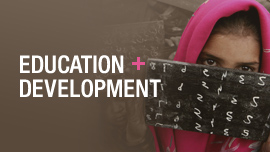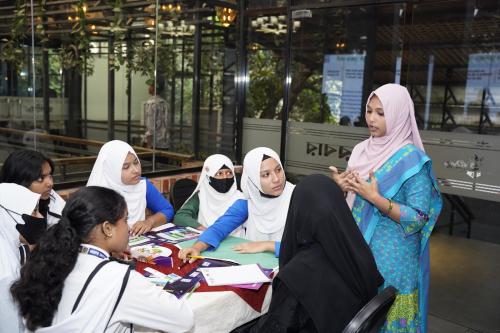Over a hundred people gathered at Stanford University late last week to think big about education for Syrian refugees. It was the first “Innovation Forum” in a series to be organized by the U.S. Department of State. The room was full of app developers, online content curators, corporate social responsibility officers for tech corporations, NGOs, U.N. agencies, and armfuls of Post-It notes.
In the lightening talk I gave, I emphasized four critical dimensions of support for refugees’ learning that our research has uncovered. First, refugees cannot learn if they are not physically and emotionally safe. Second, refugee children cannot learn without intensive language support. Third, refugee children’s learning will not prepare them for the future if it is not certified. And finally, refugee children need to learn through education that they belong. (For more on these issues, please see ‘For Syrian children and youth, education is the front line’.)
We left the day with some exciting ideas to prototype and test in response to these challenges. Some of the ideas are new, some are old and in need of refinement: an app for shared rides to address transportation barriers that prevent refugee children from reaching schools; a virtual teacher-training program focused on creating inclusive, trauma-sensitive environments; a curated bundle of accredited online materials.
I came away from the conversations with four broad and related impressions that can help to shape the engagement of the tech community on issues of refugee education: the need to avoid duplication among well-meaning individuals and organizations that are distant from the crisis; the need to understand the existing endeavors of refugee communities; the need to avoid short-term fixes and instead to focus on long-term funding for refugee education from multiple sources; and the need to understand deeply the daily experiences of Syrian refugee children and their teachers in schools to avoid a one-size-fits-all approach.
First, we need to avoid duplication. Deputy Secretary of State Tony Blinken challenged the group to think of solutions collectively, describing the challenge of educating Syrian refugees as one that no one can solve alone. The scope of the challenges indeed requires big thinking. There are 5.4 million children and youth in Syria in need of educational support, and 2.1 million of them are out of school. An additional 1.4 million Syrian children and youth live in exile in neighboring countries, where half of them are out of school. Moreover, issues related to quality education have been overlooked in the face of these urgent access issues. The scope of the challenges requires unwavering efforts to coordinate innovations and to build on the efforts of others.
Second, Shelly Culbertson, policy analyst with the RAND Corporation, reminded the group that the best ideas may start very simple and may originate in the refugee community. She spoke of a refugee father who took action when so many children in his community, including his own, were not in school. She said:
“He got a pad of paper and a pen, and walked door-to-door to all of the houses in the villages nearby to create a list of the Syrian children, their ages and grade levels, their parents’ names, and their cell phone numbers. In other words, he took it upon himself to create a rudimentary data system about educational needs.”
He then advertised for teachers through Facebook. Refugees themselves are leveraging technology in remarkable ways. It remains important for us to be vigilant listeners and learners about existing work, and to amplify it if needed.
Third, as Rania Succar of Google and Jusoor noted, “money is clearly the biggest barrier to ‘solving’ this challenge.” Education is notoriously underfunded in humanitarian situations. In 2015, the education portion of the Syria Humanitarian Response Plan – a collective plan for Syria produced by the United Nations Office for the Coordination of Humanitarian Affairs and other humanitarian actors – was only 23 percent funded. In the U.N. High Commissioner for Refugees (UNHCR) Regional Refugee Response Plan for Syrian refugees, education needs were funded at only 46 percent. This week’s Syria Donors Conference will focus on a long-term commitment to the education of Syrians with a total ask of $1.4 billion. The funding aims to ensure that all conflict-affected Syrians inside and outside of Syria will have access to “safe, inclusive, and quality formal and non-formal certified learning opportunities.” Non-traditional sources of funding from the tech sector cannot replace this desperately needed core funding, but they could leverage it to help improve the futures of millions of Syrian children and youth.
Finally, the group was reminded of the need to steer away from one-size-fits-all solutions. Many of those gathered shared from experience that innovations developed in New York or Silicon Valley proved to be poor solutions in Beirut or Amman. Understanding the challenges of refugee teachers and students requires spending time with them as they seek to teach and learn. Along these lines, next week, we will launch a blog series in this same space called “Inside Syrian Refugee Schools.” Drawing on long-term observations and interviews in Lebanon in schools that serve Syrian refugees, we will explore the experiences of Syrian refugee children and their teachers.
The Brookings Institution is committed to quality, independence, and impact.
We are supported by a diverse array of funders. In line with our values and policies, each Brookings publication represents the sole views of its author(s).




Commentary
Thinking big on Syrian refugee education
February 3, 2016